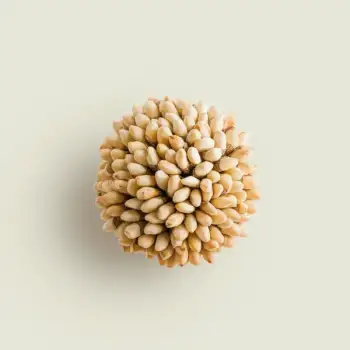Pumpin seeds and pine nuts differ in flavor and texture. Pumpkin seeds, or pepitas, provide a crunchy, nutty taste, while pine nuts feature a soft, buttery flavor, ideal for adding a subtle, sweet touch to dishes in various cuisines.

Pumpkin seeds, also known as pepitas, are the edible seeds of a pumpkin. They are typically flat and asymmetrically oval, have a chewy texture, and feature a mellow, nutty flavor.

Pine nuts are the edible seeds of pine trees. They are small, elongated, and have a soft, buttery texture with a subtle, sweet, and resinous flavor that is highly prized in various cuisines.
Pumpkin seeds have a robust, earthy flavor and a satisfying crunch, making them ideal for adding texture to dishes. Pine nuts, on the other hand, are creamier and more delicate, with a flavor that enhances rather than dominates. Pumpkin seeds are harvested from pumpkins, while pine nuts come from the cones of certain pine tree species.

Your ultimate Recipe Box, Meal Planner, and Cooking Class all in one
In salads, pumpkin seeds add a delightful crunch and a boost of protein. They work well in hearty, leafy salads such as a kale or spinach salad, especially when roasted and salted. Pine nuts can elevate a simple salad with their buttery texture and rich flavor. They are a classic addition to pesto salads or salads with Mediterranean influences, such as a Caprese.
Pumpkin seeds can be incorporated into breads, muffins, and cookies for added texture and nutrition. They provide a nutty flavor and a chewy bite to complement sweet and savory baked goods. Pine nuts are often used in Italian cookies and pastries, like pignoli cookies. Their buttery flavor and tender texture melt into the dough, creating a luxurious mouthfeel and a sophisticated taste.
While not traditional, pumpkin seeds can be used to make a rustic and hearty pesto. They blend well into sauces, offering a nutty undertone and a more textured finish. Pine nuts are the classic choice for authentic Italian pesto. Their creamy texture and sweet flavor create a smooth and rich sauce that pairs perfectly with pasta.
Both pumpkin seeds and pine nuts are rich in healthy fats, protein, and various minerals, making them a nutritious addition to your diet.
| Nutrient | Pine Nuts ( per Ounce ) | Pumpkin Seeds ( per Ounce ) |
|---|---|---|
| Fat | 19.1g | 13.9g |
| Zinc | 2.8mg | 2.2mg |
| Fiber | 1.1g | 1.7g |
| Protein | 3.9g | 8.5g |
| Calories | 191 | 158 |
| Magnesium | 71mg | 168mg |
| Carbohydrates | 3.7g | 1.7g |
While pumpkin seeds can be used as a substitute in many recipes, the flavor and texture will be different. They are best substituted in recipes where a nutty crunch is desired, rather than in dishes where a soft, buttery texture is crucial.
Pine nuts have a unique flavor and texture that can elevate certain dishes, particularly those in Mediterranean cuisine. Whether they are worth the extra cost depends on personal preference and the importance of authenticity in the recipe.
Pumpkin seeds are not nuts; they are seeds. However, individuals with nut allergies should consult with an allergist, as some people with nut allergies may also be sensitive to seeds.
Both should be stored in airtight containers. Pumpkin seeds can be kept at room temperature, while pine nuts, due to their high oil content, should be refrigerated or frozen to prevent rancidity.
Both can be roasted to enhance their flavor, but they require different roasting times due to their size and fat content. Pine nuts are smaller and more delicate, so they need to be watched closely to prevent burning.